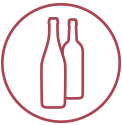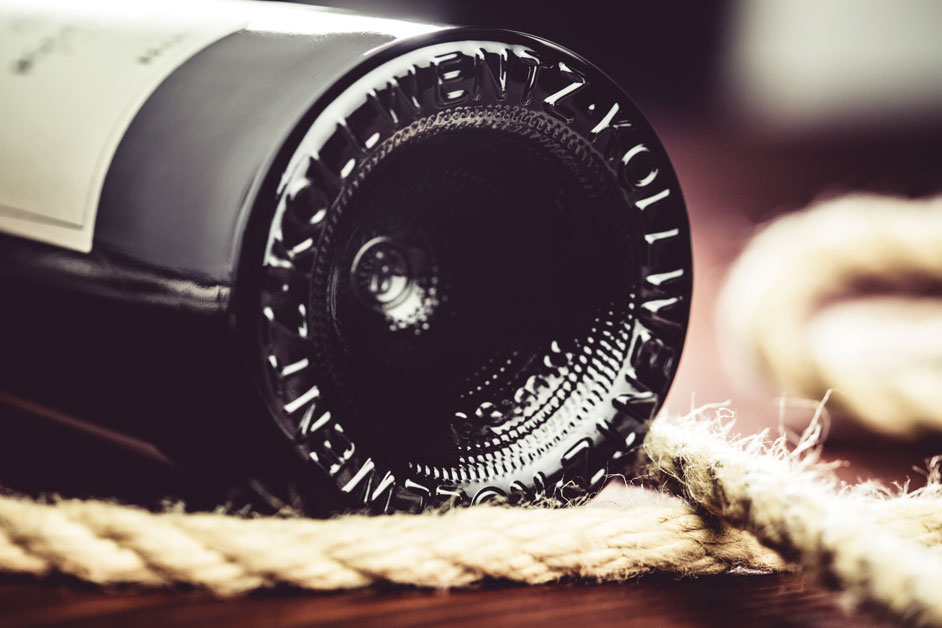
Wine bottles
From a technical point of view, a wine bottle protects its contents from harmful external influences. Wine bottles are – let's assume – always made of glass. The precious content is contained in packaging that is 100 % inert.
Glass is the only material that, as a packaging material, does not trigger a chemical reaction with its contents. You can’t get any healthier packaging than that. Moreover, glass protects against harmful UV rays, which can impair the quality of the wine. In addition to their functional task, wine bottles also play a key role in product design. The bottle shape is the first thing to give customers a clue as to what’s inside, allowing initial conclusions to be drawn about the content and its value.
The history of the wine bottle
The oldest wine bottle in the world is exhibited in a museum in Speyer, Germany. It was discovered in a Roman tomb and dates back to the 4th century AD. As we now know, the Romans stored their wine in bottles, although back then these were balloon-shaped containers. As of the 17th century, the use of bottles for storing wine spread throughout Europe. Due to the breakability of glass, however, clay or stoneware still retained the upper hand. All this changed with advances made in glass processing. While bottles from that period were still rather squat with a broad base and a long, slender neck, by the 19th century the shape we know today had begun to dominate.
Essentially, these are the main bottle shapes:
The history of the wine bottle
The oldest wine bottle in the world is exhibited in a museum in Speyer, Germany. It was discovered in a Roman tomb and dates back to the 4th century AD. As we now know, the Romans stored their wine in bottles, although back then these were balloon-shaped containers. As of the 17th century, the use of bottles for storing wine spread throughout Europe. Due to the breakability of glass, however, clay or stoneware still retained the upper hand. All this changed with advances made in glass processing. While bottles from that period were still rather squat with a broad base and a long, slender neck, by the 19th century the shape we know today had begun to dominate.
Essentially, these are the main bottle shapes:
- Albeisa
- Bocksbeutel
- Bordeaux Bottle (Bordelaise Grande Tradition)
- Borgognotta
- Burgunderflasche (Bourgogne)
- Champagne bottle (Champenoise)
- Elsässer Flöte (Flûte d’Alsace)
- Fiasco
- Keulenflasche (Mace-shape bottle)
- Port wine bottle
- Rheingauer Flöte (Rheingau flute)
- Schlegelflasche (Schlegel bottle)
These days, the majority of all wine bottles around the world are based on three basic shapes: the Bordeaux bottle, the Burgundy bottle and the Rhine wine bottle.
What the bottle colour tells us
Wine connoisseurs are not interested only in the shape of the bottle – it’s also the colour that gives us the first inkling as to the quality of the wine inside. So, for example, clear or light bottles promise rather young and lively wines that tend to have a higher degree of acidity. Conversely, dark bottles indicate rich, heavier wines with aging potential. Green, brown and white are the standard colours for modern wine bottles. Antique blue, pale green or feuille-morte are other common shades. We have decided to base our range on the two basic colours brown and white. Using these as a starting point, however, virtually all colour gradations are possible. Something to bear in mind with any tone or product design, however, is that the darker the wine bottle, the higher its UV protection.
Quality criteria of wine bottles
An important factor in wine bottle quality is the wall thickness, which determines the weight of the bottle and consequently the impression that it makes on the customer. A bottle’s wall thickness is of course also responsible for its stability and the safety of the packaging. It also determines the type of finish, particularly in wine bottles, as well as which type of closure ultimately seals the bottle. The most common types of closures for wine bottles are the cork, the twist-off cap and the somewhat less popular glass stopper. These closures not only influence the quality of the bottle’s content, they also characterise the product design.
With our range, and particularly so with projects in our CRISTALLO UNICO series, we seek to give you complete freedom to decide what type of closure you would like.
What the bottle colour tells us
Wine connoisseurs are not interested only in the shape of the bottle – it’s also the colour that gives us the first inkling as to the quality of the wine inside. So, for example, clear or light bottles promise rather young and lively wines that tend to have a higher degree of acidity. Conversely, dark bottles indicate rich, heavier wines with aging potential. Green, brown and white are the standard colours for modern wine bottles. Antique blue, pale green or feuille-morte are other common shades. We have decided to base our range on the two basic colours brown and white. Using these as a starting point, however, virtually all colour gradations are possible. Something to bear in mind with any tone or product design, however, is that the darker the wine bottle, the higher its UV protection.
Quality criteria of wine bottles
An important factor in wine bottle quality is the wall thickness, which determines the weight of the bottle and consequently the impression that it makes on the customer. A bottle’s wall thickness is of course also responsible for its stability and the safety of the packaging. It also determines the type of finish, particularly in wine bottles, as well as which type of closure ultimately seals the bottle. The most common types of closures for wine bottles are the cork, the twist-off cap and the somewhat less popular glass stopper. These closures not only influence the quality of the bottle’s content, they also characterise the product design.
With our range, and particularly so with projects in our CRISTALLO UNICO series, we seek to give you complete freedom to decide what type of closure you would like.
Let us bring you to your senses
The countlessfacets of wine
It is important to express this very aspect in the packaging. Why stick to old norms when you don't need to?
Before a wine enthusiast can even savour the content, the bottle already speaks volumes. We help you communicate this effectively. Based on the three classic shapes – the Bordeaux, the
Burgundy and the Rhine wine bottle – a whole wealth of possibilities lies before you.
The basic decision
Your project starts with this basic decision. Legal and technical requirements present no obstacle. Optimum UV protection in our antique colour tone goes without saying. Perhaps other providers will tell you all this too. But things get really exciting when we start talking about shoulder height, bottom, embossing, reliefs and closure variants.In a league of its own
As of this moment, you will notice that we are now playing in a completely different league - and will continue to do so until the perfect finishing has been achieved. And best of all, there is no obligation to place any kind of three-year order requirement. After all, we are specialists in the quantities YOU want. Anything from 1,000 units. Try us out!Each bottle a work of art
Any good wine is made with great selflessness and care. Each and every drop reflects the dedication and passion of the winegrower. Well protected, it is matured to become a sophisticated beverage before going into the bottle. So shouldn't that bottle itself embody such passion? The wine bottle is not merely a container, it also serves as protector and messenger. That's why we make every effort to create unique bottles for unique wines. We always give our all. For every bottle, from start to finish.


